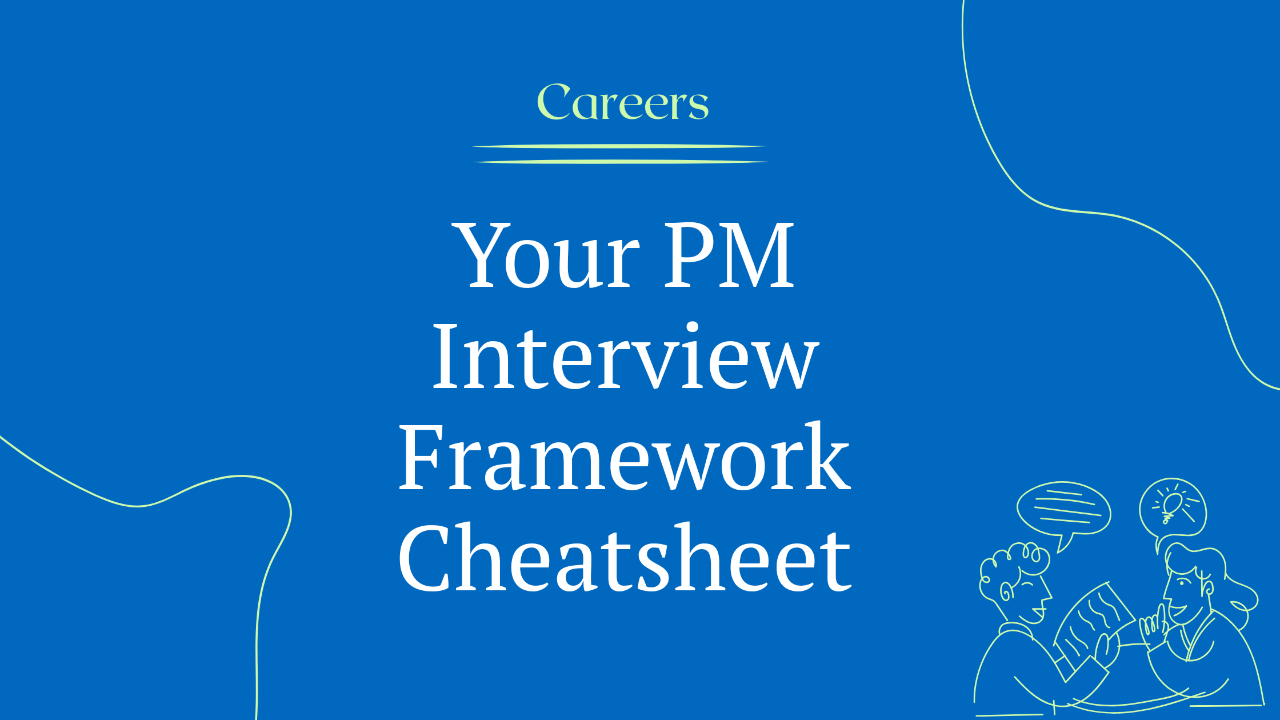💼 [Cheatsheet] Product Management Interview Frameworks for Every Question Type
Oct 29, 2025
One of the fastest ways to level up your interview prep is to stop guessing and start structuring your answers.
Frameworks help you:
-
Stay calm under pressure
-
Show clear thinking and prioritization
-
Avoid rambling or jumping around
-
Tailor your answers to what interviewers actually want to hear
Below is a full cheat sheet of interview frameworks — organized by question type — to help you stand out and sound like a product leader from day one.
Behavioral & Leadership Interviews
Example: "Tell me about a time you had to convince leadership on a project."
🎯 Use the SAR + Influence Stack
SAR Framework
-
S: Situation
-
A: Action
-
R: Result
▶️ Use this to structure your story and show outcomes.
Influence Techniques (to layer on top of SAR)
-
Reciprocity – How did you earn trust?
-
Scarcity – Was there a deadline or urgency?
-
Authority – Did you bring in an expert or data source?
-
Consistency – Did you align with existing plans or goals?
-
Consensus – Did you rally the team around shared outcomes?
Product Strategy Interviews
1. Business Expansion
Question: “What market should Airbnb expand into?”
🧩 CASE Framework
-
Context: What is the product, user need, or business goal?
-
Analysis: Dive into Customer, Company, Competition, and Market
-
Solutions: Explore multiple options and trade-offs
-
Evaluate: Recommend one path based on clear criteria
2. Should We Launch This?
Question: “Should Google charge for Gmail?”
⚖️ Pros/Cons Framework
-
Break down the impacts for:
-
Customer: Benefits, segmentation, expectations
-
Product: Alignment, lifecycle, use cases
-
Company: Strategic fit, brand, revenue
-
Competition: Threats, best practices, new entrants
-
Wrap with a final recommendation for or against.
3. Acquisition Strategy
Question: “Should Company A acquire Company B?”
🔗 Fit Framework
-
Compare Company A, Company B, and A + B
-
Customers
-
Products
-
Strategic value
-
Market position
-
-
Conclude with:
-
Benefits (internal + external)
-
Costs (integration risk, cultural mismatch)
-
4. Product Pricing
Question: “How should we price the new Kindle?”
💵 CAR Framework
-
Competitors: Price ranges, business models
-
Audience: Who are they? What will they pay?
-
Revenue Alternatives: Other ways to monetize
-
Final recommendation based on user, company, and market fit
Product Sense & Design Interviews
Question: “How would you improve Uber?”
🧠 GAPS Framework
-
Goal – What problem are we solving?
-
Audience – Who is the user? Segment further
-
Pain Points – What friction exists today? Prioritize
-
Solution – What are the options? Use criteria to choose
Analytics & Execution Interviews
1. Measuring Success
Question: “How would you measure Instagram Stories?”
📏 GUMS Framework
-
Goal – Business, user, ecosystem
-
User Journey – Touchpoints + behaviors
-
Metrics – AARRR or custom funnel
-
Solution – What’s the most meaningful metric?
2. A/B Test Trade-Offs
Question: “A/B test shows more signups but lower retention. What now?”
🧬 HMM Framework
-
Hypothesis – What are we testing and why?
-
Method – How did we set up the test?
-
Metrics:
-
Success metric (primary goal)
-
Tracking metrics (supporting context)
-
Counter metrics (what got worse?)
-
-
Include trade-offs, limitations, and recommendations
3. Diagnosing a Drop
Question: “Google Cloud subscriptions dropped 20%. What’s the issue?”
🩺 CPP Framework
-
Categorize:
-
External: Industry shifts, PR, regulation
-
Internal: Bugs, releases, funnel stages, segment changes
-
Funnel: Where is the drop?
-
-
Prioritize issues by likelihood + impact
-
Plan your next steps: data to pull, teams to sync with
4. Tradeoffs
Question: “Comments are down, but Reactions are up. What do you do?”
Framework:
-
List the pros and cons of both metrics
-
Clarify if this is actually a problem
-
Weigh against product goals + user value
Technical Interviews
1. System Design / Architecture
Question: “Design the backend of Reddit.”
Steps:
-
Clarify constraints and principles (e.g., reliability, cost, scale)
-
Sketch a high-level architecture
-
Dive deeper:
-
Storage
-
APIs
-
Data models
-
Caching
-
Real-time updates
-
2. Explain It Like I’m Five
Question: “How does the internet work?”
Break it into:
-
User Journey – High-level walkthrough
-
Feature Deep-Dive – Auth, permissions, data
-
Diagram or Flow – Include client-server flow, API calls, and concurrency
Final Thought
You don’t need to memorize all of this.
You need to practice thinking in frameworks — not just repeating them.
When you hit a question in an interview, pause.
✅ Choose a structure. ✅ Think out loud. ✅ And walk your interviewer through your logic.
The clarity, confidence, and composure that comes from structured thinking? That’s what sets you apart.
📌 Try This: Framework Practice Plan
Day 1–2: Practice GAPS and GUMS
Day 3–4: Write out answers using CASE and Pros/Cons
Day 5: Do 2 mock interviews using SAR and HMM
Day 6: Sketch a system design
Day 7: Reflect and repeat what felt messy or rushed
Welcome to Ambition Redesigned! Where purpose meets progress.
Get one actionable tip delivered to your inbox every Monday.


